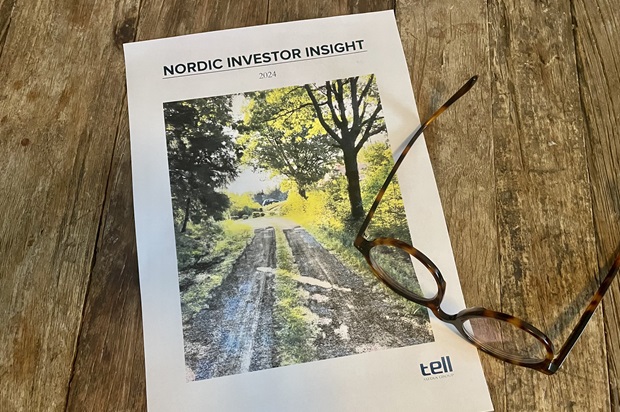
Backtests, investment horizons and ESG quant dilemmas
Earlier this fall, Tell Media Group, in cooperation with Dimensional, Intech and Man Numeric, invited institutional investors to discuss systematic equity investing. Tell Media Group founder Niklas Tell and Nordic Fund Selection Journal editor Caroline Liinanki moderated the roundtable.
The discussion started out with Caroline Liinanki asking the investors about their current systematic equity exposure.
CARL FREDRIK POLLACK: “We embarked on a journey of including equity risk premia a few years ago, which we saw as a diversifying step for the fund. We’re a long-term pension fund but our set-up is different from many others due to the platform on which we operate. This means that we manage two separate funds – one global equity fund and a local fixed income fund, so as far as cross asset systematic strategies are concerned, that’s currently out of scope for us. Within global equities, however, we’re not limited to cash equity premia, so non-linear systematics strategies as well as FX could well be within our scope. Our main focus has, however, been on the equity risk premia.”
THOMAS EKSTRÖM: “We started using systematic strategies some five years ago when we implemented a low volatility strategy. More recently, we’ve started implementing other types of strategies within the portfolio, such as momentum, quality, ESG and value.”
NIKLAS TELL: THERE MIGHT BE SLIGHTLY DIFFERENT TAKES ON WHAT SYSTEMATIC INVESTING MEANS. HOW WOULD YOU DEFINE IT AND WHAT ARE SOME OF THE STRENGTHS OF SYSTEMATIC INVESTING?
DAVID SCHOFIELD: “When I attempt to differentiate what we do from more traditional quantitative approaches, I use the term mathematical rather than systematic. That’s because our approach doesn’t involve any analysis of fundamental data whatsoever and doesn’t involve any attempt to identify which stocks will outperform or underperform. It’s a process that was designed based on academic research done in the early 1980s on stochastic portfolio theory, which points out that diversification itself is a source of return. So it’s about building more diversified portfolios and the only metrics you need to focus on in order to do that are volatility and correlation. Then you of course need to maintain that more diversified portfolio, because if you do nothing it will become less diversified. I think one of the strengths of our approach, but also of quantitative approaches generally, is the ability to approach equity management in a very disciplined manner with a high degree of risk control and the ability to generate a high level of consistency with controlled risk. I think that’s one of the things that users of quantitative strategies should be demanding from their managers – a high level of consistency that’s implied by high information ratios.
WES CRILL: “Dimensional was founded long before the term systematic investing had been coined. What it meant to us was taking some of the many benefits associated with passive index investing – diversification, low cost and transparency – and then finding a way to add to that. That means seeking to do better than the market without trying to outguess the market and then adding robust risk management. I agree with David that risk management is a key part of systematic investing and a key differentiator relative to traditional active stock picking. We rely on decades of academic evidence to identify drivers of expected returns. Not at all surprisingly, it turns out that how much you pay and what you expect to receive are the drivers of expected returns. Those issues are relevant for any purchase decision you make. Knowing those drivers means we can systematically over- and underweight certain groups of stocks as we seek to outperform the market and this process is repeatable. It’s not subject to where we are in the market cycle or what has been happening in the economy. I think those are the main characteristics of a truly systematic investment process.”
GREGORY BOND: “For us, it’s really a combination of some sort of fundamental or behavioural anomaly that we can take advantage of in the market. That has been driving our investment philosophy and model design. Everything needs to be tied back to some fundamental or behavioural notion. The way you define that over time has of course grown, given the amount of new data and new technologies. I think another advantage of systematic investing is that you can incorporate these new ideas and new data sources in a very systematic way. Another benefit that we’ve seen, particularly over the last decade or so, is the ability to build customisable solutions for clients. A lot of clients have different needs and it’s really about the ability to navigate and make your strategies fit with what the clients are looking for. Returns and risk are of course very important but there are also other values that are expressed by the portfolio, such as ESG.”
The roundtable discussion was published in issue 05 of Nordic Fund Selection Journal and a PDF of the complete story can be found here.
//Participants
- CARL FREDRIK POLLACK: Head of risk management and allocation at AP7
- THOMAS EKSTRÖM: Senior quantitative analyst at AP1
- WES CRILL: Head of investment strategists at Dimensional
- DAVID SCHOFIELD: President of Intech International
- GREGORY BOND: President and CEO of Man Numeric



